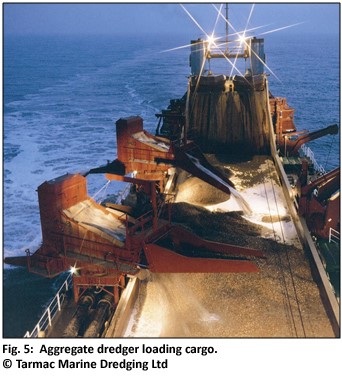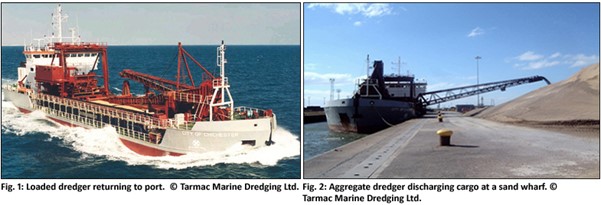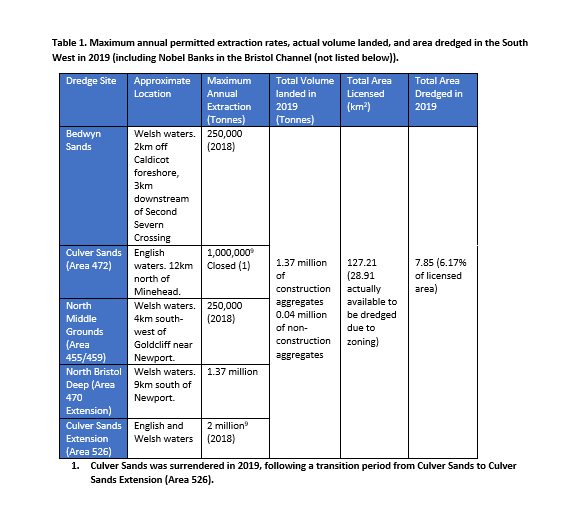Marine Aggregates
Marine aggregate is sand or gravel, used principally as a raw material by the construction industry. In the UK, the majority of aggregate (including crushed rock) comes from land-based sources but since the 1960s, developers have been increasingly reliant on marine sources to supplement demand and meet construction needs.
The Severn Estuary contains extensive areas of sandbanks. It is estimated that the sand bank system between Newport and Chepstow, known as the Middle Grounds, contain quantities in excess of 1700 million cubic metres2 alone. These sandbanks were not formed by modern processes but are derived from periods of glaciation and major changes in sea level that ended approximately 4,500 years ago. Though there appears to be no major modern source of sand, it is considered likely that limited inputs from the Bristol Channel occur under certain oceanographic conditions.


The pattern of sand supply for construction purposes around the Severn Estuary, particularly in South East Wales, is unique in the UK because of its current and historic dependence on marine dredged resources. These marine resources are of significant commercial interest as the sand dredged is of high quality, with well sorted grain-sizes and virtually no wastage. There are also significant manufacturing and production benefits, further supplemented by the industry’s ability to land large tonnages by sea, close to urban areas.
In 2020, 2.7 million tonnes can be extracted from 7 licences annually in the South West region, with 30 years of primary marine aggregate production permitted. This data includes the licensed dredge areas in the Bristol Channel.
Regulation
The Crown Estate owns the mineral rights for much of the UK seabed and issues commercial licences for both prospecting and the extraction of aggregates. However, the planning and consenting process is the responsibility of the regulator; the Marine Management Organisation in England and the Welsh Government administered on its behalf by Natural Resources Wales who, through a consultation process, determine whether an area can be used for aggregate extraction. If it is deemed acceptable, a Marine License is issued under Part 4 of the Marine and Coastal Access Act 2009. The exception in the Severn Estuary is the Bedwyn Sand reserve. This area of sand bank is owned by the Swangrove Estate and lies within the jurisdiction of Gloucester Harbour Trustees (Navigation Authority) and as the sand bank is contiguous with the foreshore, it also falls within the jurisdiction of the local Mineral Planning Authority, Monmouthshire County Council. Consequently, the operator needs permissions from several bodies in addition to a Marine License.

The Severn Estuary
Aggregate extraction from the Severn Estuary is exclusively of sand; the resource consists of well-sorted fine to medium grained sand mainly used as building sand. The sandbanks generally contain thick deposits, but they mainly exist in shallow water or inter-tidal settings that restrict access to dredgers during low water.
The Inner Bristol Channel
The largest licence in terms of the annual upper tonnage limit, in the Severn Estuary area applies to the Culver Sands Extension area. This area replaced Culver Sands and has a licensed maximum annual extraction rate of 2m tonnes.
Dredging in 2019
The combined maximum licensed annual extraction rate during 2019 for the South West region of the UK was 2.7 million tonnes. The total volume of construction aggregate landed in 2019 was 1.37 million (+0.04 million of non-construction aggregates). No data is available for Bedwyn Sands, but using the average volume landed over the previous 7 years, the combined total is likely to have been approximately 1,235,000 tonnes, 75% of the combined permitted volume.
The dredged sand is delivered to dedicated sand wharves principally at Cardiff, Newport and Avonmouth, and occasionally at Chepstow and Bridgwater.

 Severn Estuary Partnership
Severn Estuary Partnership